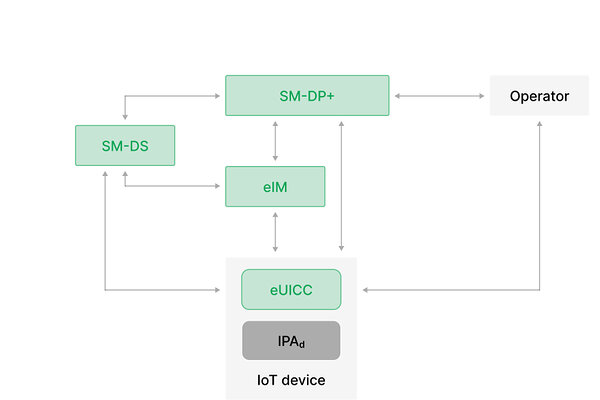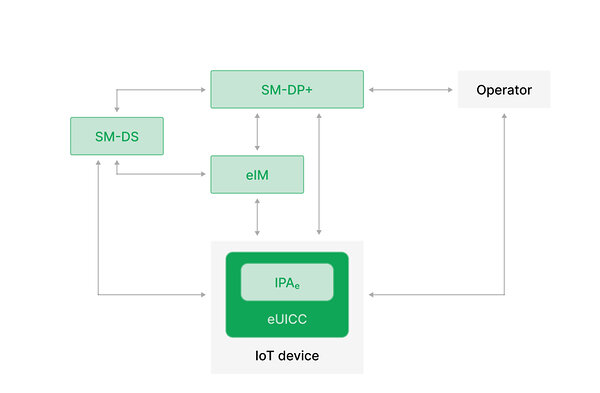There is a lot of buzz around the IoT eSIM (SGP.31/32) standard, which combines the best of both M2M eSIM (SGP.02) and consumer eSIM (SGP.22) specifications. In case you are new to eSIM, we have written several blog posts comparing M2M eSIM and Consumer eSIM, and here’s a good introduction for you.
Before we delve into what the IoT eSIM is and how it works, we are excited to announce a new blog series on the IoT eSIM standard — IoT eSIM Diaries.
At 1oT, we value transparency and have decided to share our journey of bringing the standardized solution of IoT eSIM (SGP.32) to the market.
This means we’ll work with our garage door open to share learnings from developing the necessary components, navigating the commercial landscape, and testing with real-life applications. Our aim is to provide more practical insights into the world of eSIM and prompt interesting discussions within the industry.
What does the IoT eSIM standard’s architecture look like?
Before we dive deeper into each component of the IoT eSIM standard, let’s first review its architecture.
The IoT eSIM standard is based on the Consumer eSIM standard, but there are some specific differences between them.
The Subscription Manager - Data Preparation+ (SM-DP+) still functions like in Consumer eSIM. It is responsible for hosting eSIM profiles and their preparation and download.
The Local Profile Assistant (LPA) component of the Consumer eSIM specification is now divided into two modules.- The eSIM IoT Remote Manager (eIM) sends profile state management operations to the eSIM. These enable, disable, delete profiles, and trigger profile downloads.
- The IoT Profile Assistant (IPA) is a proxy between the eSIM and the eIM. It can be located either in the device (IPAd) or on the eUICC OS (IPAe). IPA enables functions that allow eSIM profiles to be downloaded and installed via SM-DP+. It may also offer discovery services via SM-DS.
What are the improvements of this new standard?
At 1oT, we have always been strong advocates of eSIM technology.
The ability to change telecoms after deployment without having to replace the SIM card in the device offers significant efficiency, cost, and time benefits. This means that companies of all sizes can simplify the deployment process and enable global roll-outs without complicating the supply chain. eSIM technology also future-proofs deployments against coming network shutdowns, price, or regulatory changes.
The new IoT eSIM standard offers significant improvements over the existing M2M eSIM standard, which is mainly used in the IoT and M2M arena.
One major improvement is that the new standard eliminates the SM-SR lock-in, which is a problem with the M2M standard. With IoT eSIM, any device can communicate with any SM-DP+ without needing pre-configured integrations, avoiding technical integrations between network operators. This enables the triggering of profile downloads without vendor lock-in.
Another advantage of the new standard is that, unlike the M2M eSIM standard, SMS is not required to complete the profile download. This is particularly important for network-constrained IoT (e.g., NB-IoT) devices that may not have SMS capabilities. The new standard supports a wider range of protocols to cover different device categories.
- For broadband devices, there is HTTP/TCP/TLS.
- For network-constrained devices, this is CoAP/UDP/DTLS.
For devices with already implemented dedicated IoT protocols (for example, used for other functions of the IoT device), this could be LwM2M or MQTT/TCP.
The new IoT eSIM standard uses both push and pull models for profile downloads and, therefore, offers more flexibility and control over the provisioning process.
In summary, the new IoT eSIM standard is designed to ensure that devices with either limited network or limited user interface capabilities can still benefit from modern connectivity solutions that are secure, flexible, and manageable at scale. The key benefits are that it enables remote management of profiles without integration between operators and leaves control of provisioning to IoT customers rather than operators.
What’s the current status quo? How far is the spec from commercial use?
The demand for simple and scalable eSIM solutions is high, which has led to many pre-standard options being available on the market. However, some of these options give false hope or implement IoT eSIM standards with technical choices that still need to be officially decided by the GSMA.
Currently, the GSMA has published two documents — Architecture and Requirements (SGP.31) and Technical Specification (SGP.32). Both are version 1 documents, so upon closer inspection, you can see some gaps in the description that will hopefully be specified with the next releases.
The next important milestone would be the publication of the functional test specification (SGP.33). These test specifications will enable the development of official test tools, allowing IoT eSIM builders to test their solutions according to the official specification.
Another crucial step is the availability of eUICCs for the IoT eSIM standard. Let's refer to them as IoT eUICCs. To the best of 1oT's knowledge and understanding today, there are currently no IoT eUICCs available. This means that IoT eSIM builders cannot test either eIM-eUICC or eIM-IPA interfaces and functions.
However, today, you can find and run proof-of-concept projects with proprietary solutions that use the Consumer eUICC with a SIM applet that adds IoT eSIM functionality.
Since the new IoT eSIM standard re-uses many elements of the consumer eSIM specification, it’s possible to claim a working solution of the IoT eSIM standard. However, there are still some crucial steps that need to be taken before market-standard solutions become widely available.
Sign up for our monthly newsletter to stay up-to-date with our progress, or be the first to know about new blog posts in this series.
If you are interested in experiencing this technology firsthand, you can join 1oT's eSIM SGP.32 mailing list.


